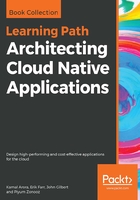
上QQ阅读APP看书,第一时间看更新
Example – asynchronous API documentation
The following is an example of documenting the event types that have been used throughout the examples in this chapter. TypeScript interfaces are a concise way to document the structure of JSON payloads. These can be leveraged in the code itself when using Node.JS to implement components, but they are useful on their own, regardless of the implementation language. Notice that the ItemChangeEvent format includes both the old and new image of the data. This information is usually provided by a cloud-native database's change data capture feature. Both images are included, in the spirit of including all available context information, so that consumers can calculate deltas if need be.
// Event Envelope Definition
export interface Event {
id: string;
type: string;
timestamp: number;
partitionKey: string;
tags: { [key: string]: string | number };
}
// Item Domain Entity Definition
export interface Item {
id: string;
name: string;
status: Status;
description: string;
}
export enum Status {
Wip = 'wip',
Submitted = 'submitted',
Approved = 'approved',
Published = 'published',
}
// Item Event Definitions
export interface ItemEvent extends Event {
item: Item
}
export interface ItemChangeEvent extends Event {
item: {
old?: Item,
new?: Item,
}
}
// Valid Event Types
export const ITEM_CREATED_EVENT = 'item-created';
export const ITEM_UPDATED_EVENT = 'item-updated';
export const ITEM_DELETED_EVENT = 'item-deleted';
export const ITEM_SUBMITTED_EVENT = 'item-submitted';
export const ITEM_APPROVED_EVENT = 'item-approved';
export const ITEM_PUBLISHED_EVENT = 'item-published';